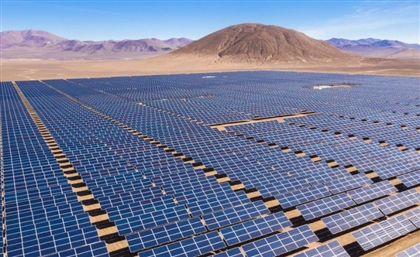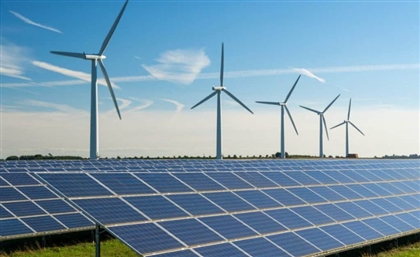Is There a Green Light at the End of Egypt's Tunnel?
From massive investment in renewable energy to the promise of three, new eco-friendly cities, Eihab Boriae wonders if Egypt could be poised to become a regional leader on the environmental issues facing the whole globe.

When President Sisi was elected into office, Egypt was facing a myriad of problems ranging from energy shortfalls and deteriorating cities, to a lack security and massive national debt. Despite waves of skepticism, President Sisi proved that building a Suez Canal expansion in a year was possible. Looking to build on this success the president seems poised to focus his intention on the next big picture project, which according to recent statements made, involve building not one, but three new cities powered by renewable energy.
Egypt’s most populous cities share congested streets and decaying infrastructure. Coupled with a shortage of quality jobs, made worse by years of post revolution instability, Egypt finds itself in massive debt, during a time where the country is in desperate need to spend money upgrading various sectors, none arguably as important as its energy grid. Identifying that a change is needed it appears that President Sisi is positioning the country to become a regional climate change leader, aiming to invest in renewable energy to make up for current energy shortfalls as well as powering the construction of new cities.
Geographically, Egypt is a perfectly located country to become a regional clean energy leader. Explaining Egypt’s unique position is Apricum's the Cleantech Advisory report suggesting that Egypt could be a “renewable energy powerhouse.” Containing an abundance of solar and wind resources, and with 2014’s September announcement of a generous feed-in tariff (FIT), Apricum expects that Egypt will procure 4.3GW of solar and wind power production by 2017. According to Apricum Project Manager and the author of the report, Martin Mitschner, "After the FIT announcement, we saw a rush from local and international solar developers to get their foot in the door. A stunning 178 project proposals were submitted for more than double the announced capacity of 2 GW.” Of the alleged 178 proposals, 69 projects achieved qualification and are pending a financial framework that appeases both Egypt’s government and proposed developers.

A positive sign that this outlook may possible is the fact that several industry leaders have express interest or signed massive deals to provide Egypt with renewable energy. One of the first renewable energy deals signed this year took place in February, which will see the Spanish company Gamesa Olica investing 220 million Euros to implement a 220MW wind power plant in Gabal El Zeit. This is only one example, as further investments were secured after the strategic Egypt Economic Development Conference (EEDC) held in Sharm el Sheikh in March, which attracted several major players in the field. One of the biggest deals to emerge was an 8 billion Euro deal with Germany’s Siemens to develop power plant technologies, including 12 wind farms and a rotor blade factory. According to an unnamed source at the Ministry of Electricity speaking to Daily News Egypt “a large number of Arab and foreign companies have obtained the tender conditions, including Sterling and Wilson, Enel Energy, FAS, Abdul Latif Jameel, ACWA Power, Orascom, SunEdison, First Solar, Lekela Power, Al Tawakol, Elsewedy Electric, Gigawatt Global, Terra Sola, Sun Power, and Scatec Solar, among others.”
With unprecedented interest in investing in Egypt’s energy sector, President Sisi has wisely used this interest to change global perception on both his leadership and Egypt’s future ambition to be regional climate change advocate. This strategy became very clear during a September 2015 meeting of the Committee of African Heads of State and Government on Climate Change in New York, where Egypt’s president called for a joint African stance on climate change to be submitted to the UN Climate Change Conference, which is scheduled to take place in France in December. Some skeptics may suggest that the president’s call is merely a PR stunt designed to change global opinions of his controversial rise to power, however, building on his statements at UN, President Sisi met with French Prime Minister Manuel Valls on Saturday, where he was officially invited to attend the the 2015 Paris Climate conference, and also announced Egypt’s plan to build three new cities powered by renewable energy that include; a new Administrative Capital, the new Alameen city and Al Galala city.
The promise of new cities is not new to Egyptians as previous presidents have proposed urban development plans that are never actualised or, worse, prove to be corrupt money pits. Trying to assure the public that the plans will be delivered, the Minister of Housing and Urban Utilities announced last Friday that construction would start in the coming weeks on Western North Coast’s Alameen city, estimating its cost at 2 billion LE. Few details have emerged about Al Galala city, but the proposed plan would be to make it an eco-friendly tourist destination on the Red Sea dedicated to the memory of the Saudi Arabian King Abdullah bin Abdulaziz Al Saud.
The most likely of the cities to be completed is the much talked about Administrative Capital. Planning to be built halfway between Cairo and Suez, President Sisi on Sunday announced that the first phase of the new city should be completed in two years. At the EEDC, UAE’s Capital City Partners (CPP), signed an initial agreement for the mega project but, in June, Egypt’s housing minister acknowledged that the negations were running into ‘complications’. Fast forward a few months, and news emerges that Egypt signed a memorandum of understanding with China State Construction Engineering Corporation (CSCEC) to finance and build part of the planned construction. The CSCEC has a proven track record of building new cities in short periods of time, but it is unclear exactly what the breakdown of involvement will be, however Housing Minister Mostafa Madbouli stated that between 80 to 85 percent of the employment for the city’s construction would be sourced domestically. Slated to start in January 2016, the total project is said to be completed in five to seven years, occupying 10,500 acres.
This strategy is bold and arguably overtly ambitious, but if successful it will decongest cities, strengthen Egypt’s energy output, create new jobs, and change the global perception of Egypt as a nation on the brink of collapse to a nation ready to lead on issues concerning the whole globe. As always, there are plenty of skeptics doubting the plan and going so far to question even its need. The same objections were raised, when President Sisi announced that the Suez Canal extension would be completed in a year. Proving analysts wrong he delivered on his promise, and although we can argue on how much it benefits the state, it will give the economy a boost, even if it is only a modest increase. Of course, the scale of this project pales in comparison to the building of new cities powered by renewable energy. However, with unprecedented interest from international companies to invest in clean energy in Egypt, and developers interested in investing in building cities, the question shouldn’t be if these projects are good for Egypt, but rather how involved will Egyptians be in building a new country and will they stand to profit?
- Previous Article Dr.Sisilove or How (Not) To Diffuse A Bomb
- Next Article Cairo Jazz Festival Beyond Stage at CJC
























